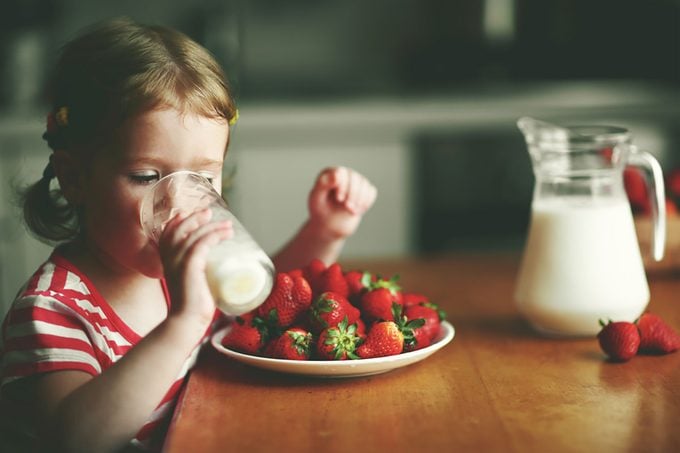Should You Be Serving Kids Organic Milk?
Updated: Jun. 01, 2023
Weighing the pros and cons of organic vs. conventional milk will help you decide what's best for your family.

That wholesome gallon of milk in your fridge (stored in the back, not in the door!) is at the center of an ongoing debate. Is it better to give your kids organic milk or conventional milk? The short answer: “Better” depends on your priorities. Considering purchase price, health factors and environmental/animal welfare can help you decide.
Purchase Price
Organic milk has a higher in-store price tag than conventional milk. If the budget option works best for your family, go conventional. For some parents, environmental/animal welfare considerations could make the higher price point the right choice for them.
Health Factors
Your kids need two to three servings of milk, yogurt and cheese a day, says the American Academy of Pediatrics. The AAP recommends 1- to 2-year-olds drink whole milk (unless obesity is a concern; then give them reduced-fat 2% milk instead). And kids older than 2 should have low-fat (1%) or fat-free (skim) milk. Here are the best organic baby yogurts for your little one.
To deliver all that good calcium, organic milk and conventional milk offer the same nutrition, according to a 2012 AAP report. A more recent study shows organic milk does have more healthy omega-3 fatty acids than conventional milk. But The Washington Post reports you’d have to drink 5-1/2 gallons of full-fat organic milk to get the same omega-3 fatty acids found in 8 ounces of salmon.
Still, the health debate goes beyond nutrition. Cows at conventional dairies are often given bovine growth hormone (BGH or rBGH) to increase milk production. Studies show that pasteurization and your own body will break down the hormone. But while the FDA says bovine growth hormone is safe, the AAP has called for more studies to understand how hormones like estrogen in milk affect children. Cows given growth hormone may also have higher levels of insulin-like growth factor, or IGF-I. Some studies have linked IGF-I to certain cancers. The American Cancer Society says the evidence is inconclusive.
For folks concerned about antibiotics in milk, the good news is that neither organic nor conventional milk contain antibiotics. Every milk tanker is tested, and if antibiotics are found, the milk is rejected. If a cow is given antibiotics, it’s not milked until the drug is out of its system. Advocates of organic farms, which cannot use antibiotics, point out that overusing antibiotics can lead to antibiotic-resistant bacteria, which would be a public health issue.
Environmental/Animal Welfare
Conventional and organic farms have different standards for how they must treat their cows. In general, organic farming practices aim to have a lower environmental impact and more natural quality of life for livestock. A 2014 study by Oregon State University found room for improvement in animal welfare in both organic and conventional dairies. To remain afloat, many family dairy farms have had to choose between becoming large-scale operations and going out of business. Several U.S. dairies now have more than 1,000 cows, and the biggest have up to 15,000. Increasingly, manure runoff from these farms is contaminating groundwater.
Because experts believe organic and conventional milk offer kids essentially the same nutrition, choosing the right milk for your family comes down to weighing priorities. If you need to save money on groceries, conventional milk costs less. On the other hand, if you want to limit the risks of hormones in your family’s diet while also supporting lower environmental impact and happy cows, choose organic milk. You can find retailers that sell organic products in your area at the Animal Welfare Approved website.
With these considerations in mind, you can make an informed decision on what’s best for your family. Well done, Mom and Dad!
